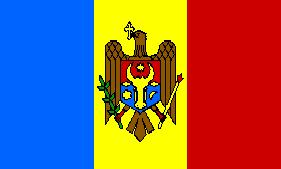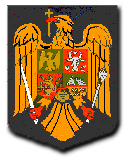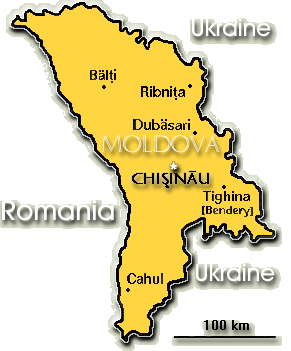Moldova



Geography
Location: Eastern Europe, between Ukraine and RomaniaArea:
total area: 33,700 sq km
land area: 33,700 sq km
comparative area: slightly more than twice the size of HawaiiLand boundaries: total 1,389 km, Romania 450 km, Ukraine 939 km
Coastline: 0 km (landlocked)
Maritime claims: none; landlocked
International disputes: no official territorial claims by either Moldova or Romania, but nationalists in Romania seek the merger of Moldova into Romania; potential future dispute by Moldova and Romania against Ukraine over former southern and northern Bessarabian areas and Northern Bukovina ceded to Ukraine upon Moldova's incorporation into USSR. Since 1992 the Russian 14th army has been supporting the the self-proclaimed Transdniester Republic, an enclave of ethnic Russians after a brief but bloody war that summer.
Climate: moderate winters, warm summers
Terrain: rolling steppe, gradual slope south to Black Sea
Natural resources: lignite, phosphorites, gypsum
Land use:
arable land: 50%
permanent crops: 13%
meadows and pastures: 9%
forest and woodland : 0%
other: 28%Irrigated land: 2,920 sq km (1990)
Environment:
current issues: heavy use of agricultural chemicals, including banned pesticides such as DDT, has contaminated soil and groundwater; extensive soil erosion from poor farming methods
natural hazards: NA
international agreements: signed, but not ratified - Biodiversity, Climate ChangeNote: landlocked
People
Population: 4,473,033 (July 1994 est.)
Population growth rate: 0.38% (1994 est.)
Birth rate: 16.02 births/1,000 population (1994 est.)
Death rate: 10.02 deaths/1,000 population (1994 est.)
Net migration rate: -2.2 migrant(s)/1,000 population (1994 est.)
Infant mortality rate: 30.3 deaths/1,000 live births (1994 est.)
Life expectancy at birth:
total population: 68.07 years
male: 64.65 years
female : 71.67 years (1994 est.)Total fertility rate: 2.18 children born/woman (1994 est.)
Nationality:
noun : Moldovan(s)
adjective: MoldovanEthnic divisions: Moldavian/Romanian 64.5%, Ukrainian 13.8%, Russian 13%, Gagauz 3.5%, Jewish 1.5%, Bulgarian 2%, other 1.7% (1989 figures)
note: internal disputes with ethnic Russians and Ukrainians in the Dniester region and Gagauz Turks in the southReligions: Eastern Orthodox 98.5%, Jewish 1.5%, Baptist (only about 1,000 members) (1991)
note: the large majority of churchgoers are ethnic MoldavianLanguages: Moldovan (official; virtually the same as the Romanian language), Russian, Gagauz (a Turkish dialect)
Literacy: age 9-49 can read and write (1970)
total population: 100%
male: 100%
female: 99%Labor force: 2.05 million (1992)
by occupation: agriculture 34.4%, industry 20.1%, other 45.5% (1985 figures)
Government
Names:
conventional long form : Republic of Moldova
conventional short form: Moldova
local long form: Republica Moldoveneasca
local short form: none
former: Soviet Socialist Republic of Moldova; MoldaviaDigraph: MD
Type: republic
Capital: Chisinau
Administrative divisions: previously divided into 40 rayons; new districts possible under new constitution in 1994
Independence: 27 August 1991 (from Soviet Union)
National holiday: Independence Day, 27 August 1991
Constitution: old Soviet constitution (adopted NA 1979) is still in effect but has been heavily amended during the past few years; a new constitution is expected in 1994
Legal system: based on civil law system; no judicial review of legislative acts; does not accept compulsory ICJ jurisdiction but accepts many UN and CSCE documents
Suffrage: 18 years of age; universal
Executive branch:
chief of state: President Mircea SNEGUR (since 3 September 1990); election last held 8 December 1991 (next to be held NA 1996); results - Mircea SNEGUR ran unopposed and won 98.17% of vote; note - President SNEGUR was named executive president by the Supreme Soviet on 3 September 1990 and was confirmed by popular election on 8 December 1991
head of government: Prime Minister Andrei SANGHALI (since 1 July 1992; reappointed 5 April 1994 after elections for new legislature)
cabinet: Council of Ministers; appointed by the president on recommendation of the prime ministerLegislative branch: unicameral
Parliament: elections last held 27 February 1994 (next to be held NA 1999); results - percent by party NA; seats - (104 total) Agrarian-Democratic Party 56, Socialist/Yedinstvo Bloc 28, Peasants and Intellectual Bloc 11, Christian Democratic Popular Front 9Judicial branch: Supreme Court
Political parties and leaders: Christian Democratic Popular Front (formerly Moldovan Popular Front), Iurie ROSCA, chairman; Yedinstvo Intermovement, V. YAKOVLEV, chairman; Social Democratic Party, Oazu NANTOI, chairman, two other chairmen; Agrarian-Democratic Party, Dumitru MOTPAN, chairman; Democratic Party, Gheorghe GHIMPU, chairman; Democratic Labor Party, Alexandru ARSENI, chairman; Reform Party, Anatol SELARU; Republican Party, Victor PUSCAS; Socialist Party, Valeriu SENIC, chairman; Communist Party, Vladimir VORONIN
Other political or pressure groups: United Council of Labor Collectives (UCLC), Igor SMIRNOV, chairman; Congress of Intellectuals, Alexandru MOSANU; The Ecology Movement of Moldova (EMM), G. MALARCHUK, chairman; The Christian Democratic League of Women of Moldova (CDLWM), L. LARI, chairman; National Christian Party of Moldova (NCPM), D. TODIKE, M. BARAGA, V. NIKU, leaders; The Peoples Movement Gagauz Khalky (GKh), S. GULGAR, leader; The Democratic Party of Gagauzia (DPG), G. SAVOSTIN, chairman; The Alliance of Working People of Moldova (AWPM), G. POLOGOV, president; Christian Alliance for Greater Romania; Stefan the Great Movement; Liberal Convention of Moldova; Association of Victims of Repression; Christian Democratic Youth League
Member of: BSEC, CE (guest), CIS, CSCE, EBRD, ECE, IBRD, ICAO, ILO, IMF, INTELSAT (nonsignatory user), IOC, ITU, NACC, UN, UNCTAD, UNESCO, UNIDO, UPU, WHO, WIPO
Diplomatic representation in US:
chief of mission: Ambassador Nicolae TIU
chancery: 1511 K Street NW, Room 329, Washington, DC
telephone: (202) 783-3012 or -2807US diplomatic representation:
chief of mission : Ambassador Mary C. PENDLETON
embassy: Strada Alexei Mateevich #103, Chisinau
mailing address: use embassy street address
telephone: 373 (2) 23-37-72 or 23-34-76
FAX: 7-0422-23-30-44
Economy
BISNIS Economic ReviewCIA Overview: Moldova has pushed ahead boldly on economic reform since gaining its independence from the Soviet Union in 1991. It introduced a convertible currency - the leu - in late 1993 that has remained stable against the dollar, removed price controls on most products, eliminated licenses and quotas on most imports and exports, and freed interest rates. In 1994, Moldova aims to privatize at least one-third of state enterprises, lower inflation to 1% per month, and reduce the budget deficit to 3.5% of GDP. Moldova enjoys a favorable climate and good farmland but has no major mineral deposits. As a result, Moldova's economy is primarily based on agriculture, featuring fruits, vegetables, wine, and tobacco. Moldova, however, must import all of its supplies of oil, coal, and natural gas, and energy shortages have contributed to sharp production declines since the break-up of the Soviet Union. Activities by separatist groups in the Dniester region have held back economic development in that area. Foreign economic assistance has been a tangible plus for Moldova, whereas direct foreign investment has been lacking.
National product: GDP - purchasing power equivalent - $16.3 billion (1993 estimate from the UN International Comparison Program, as extended to 1991 and published in the World Bank's World Development Report 1993; and as extrapolated to 1993 using official Moldovan statistics, which are very uncertain because of major economic changes since 1990)
National product real growth rate: -4% (1993 est.)
National product per capita: $3,650 (1993 est.)
Inflation rate (consumer prices): 30% per month (1993)
Unemployment rate: less than 1% (includes only officially registered unemployed; large numbers of underemployed workers)
Budget:
revenues: $NA
expenditures: $NA, including capital expenditures of $NA
note: budget deficit for 1993 approximately 6% of GDPExports: $108 million to outside the FSU countries (January-September 1993); over 70% of exports go to FSU countries
commodities: foodstuffs, wine, tobacco, textiles and footwear, machinery, chemicals (1991)
partners: Russia, Kazakhstan, Ukraine, Romania, GermanyImports: $145 million from outside the FSU countries (January-September 1993); over 70% of imports are from FSU countries
commodities: oil, gas, coal, steel machinery, foodstuffs, automobiles, and other consumer durables
partners: Russia, Ukraine, Uzbekistan, Romania, GermanyExternal debt: $325 million (end of 1993)
Industrial production: growth rate -10% (1993)
Electricity:
capacity: 3,115,000 kW
production: 11.1 billion kWh
consumption per capita: 2,491 kWh (1992)Industries: key products are canned food, agricultural machinery, foundry equipment, refrigerators and freezers, washing machines, hosiery, refined sugar, vegetable oil, shoes, textiles
Agriculture: Moldova's principal economic activity; products are vegetables, fruits, wine, grain, sugar beets, sunflower seed, meat, milk, tobacco
Illicit drugs: illicit cultivator of opium poppy and cannabis; mostly for CIS consumption; transshipment point for illicit drugs to Western Europe
Economic aid:
recipient: Joint EC-US loan (1993), $127 million; IMF STF credit (1993), $64 million; IMF stand-by loan (1993), $72 million; US commitments (1992-93), $61 million in humanitarian aid, $11 million in technical assistance; World Bank loan (1993), $60 million; Russia (1993), 50 billion ruble credit; Romania (1993), 20 billion lei creditCurrency: the leu (plural lei) was introduced in late 1993
Exchange rates: NA
Fiscal year: calendar year
Communications
Railroads: 1,150 km; does not include industrial lines (1990)
Highways:
total : 20,000 km
paved or gravelled: 13,900 km
unpaved : earth 6,100 km (1990)Pipelines: natural gas 310 km (1992)
Ports: none; landlocked
Airports:
total: 26
usable: 15
with permanent-surface runways : 6
with runways over 3,659 m: 0
with runways 2,440-3,659 m : 5
with runways 1,060-2,439 m: 8
note: a C-130 can land on a 1,060-m airstripTelecommunications: The telecommunication system of Moldova is not well developed; number of telephone subscribers 577,000 (1991); number of subscribers per 1,000 persons 134 (1991); number of unsuccessful requests for telephone service 215,000 (1991); international connections to the other former Soviet republics by land line and microwave radio relay through Ukraine, and to other countries by leased connections to the Moscow international gateway switch; 2 satellite earth stations - 1 EUTELSAT and 1 INTELSAT; broadcast services NA
Defense Forces
Branches: Ground Forces, Air and Air Defence Force, Security Forces (internal and border troops)
Manpower availability: males age 15-49 1,098,156; fit for military service 869,866; reach military age (18) annually 35,814 (1994 est.)
Defense expenditures: $NA, NA% of GDP
CIA Data Files (1994)
This page was last up-dated: